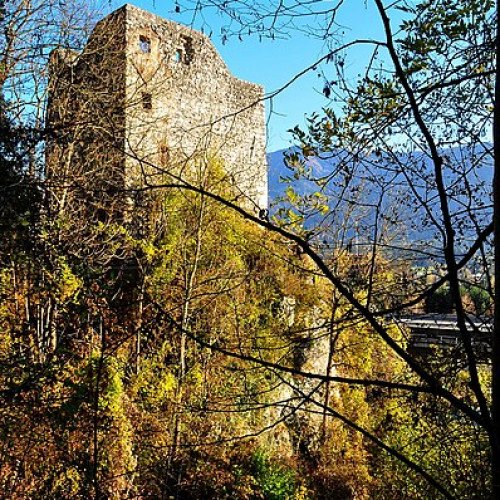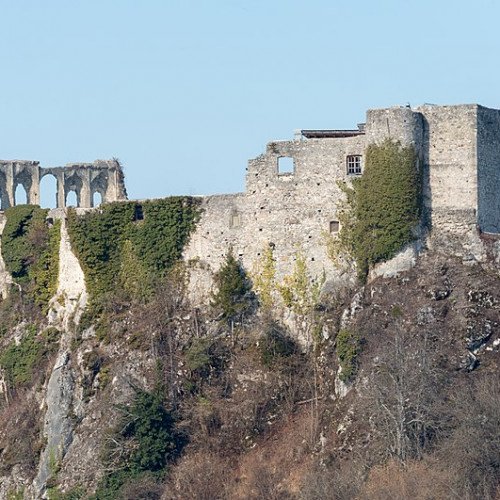Castles of "Austria" BURGRUINE FEDERAUN vs BURGRUINE FINKENSTEIN

BURGRUINE FEDERAUN
Burgruine Federaun is a castle in Carinthia, Austria. The former bambergic fortification is located directly above the historically important long-distance road Villach -Tarvis, which crosses the Gail below the Burgfelsen. The fortress also includes a bridge watchtower on a rock above the river, which served as a barrier to the street and later became a residential building. The second mentioned tower near Federaun could not be located. The castle is accessible from the east via Warmbad / Graschelitzen through a partly rocky and steep path. The oldest documentary mention of Federaun dates back to 1311. In the middle of the 13th century, Rudolf von Ras (from Rosegg in the Rosental, see also Herren Von Ras) took possession of the castle and used it as a base for his robbery attacks on the transit trade Italy. In 1255 Heinrich von Bamberg Bishop put an end to this activity and expelled the robber. The decline of the Federaun castle was probably already in place before the 17th century. From the main castle, with its mighty anterior facade, there are only small remnants left. The main castle from the late 12th century is located in the western part of the heights. The Burganlage was later extended to the east. The result of these extensions is an unusually large plant with two large Vorburg plants. However, the beautifully bricked conical cistern in the courtyard is remarkable. A vault, which is not defined in time, is still in good condition. At the eastern end, the castle is secured by a deep trench.
Statistics for this Xoptio

BURGRUINE FINKENSTEIN
Finkenstein Castle (also called Altfinkenstein) is a ruined medieval castle in the market town of Finkenstein, in the Austrian state of Carinthia. It is situated on a steep cliff at the southern foot of the Karawanks mountain range, high above Lake Faak, at a height of 788 metres (2,585 ft). Today the castle ruin is the backdrop of the Burgarena, an amphitheatre with 1150 seats mainly used for concerts and festivals. First mentioned in an 1142 deed, the castle initially belonged to the Carinthian estates owned by the Prince-Bishops of Bamberg and was enfeoffed to their local ministeriales. The lords of the castle, probably related to the Osterwitz noble family, began to call themselves von Finkenstein. In 1233, a fierce feud is recorded between the Duke Bernhard of Carinthia and the Bamberg prince-bishop Count Ekbert of Andechs, whereby Lord Henry of Finkenstein sided with the Sponheim duke. When he had Ekbert captured and arrested at Finkenstein Castle, he was immediately banned by Pope Gregory IX; nevertheless, the prince-bishop was not released until various pressures by Duke Frederick II of Austria and the Salzburg archbishop. After the extinction of the Carinthian Finkensteins at the beginning of the 14th Century –a cadet branch of the family named Finck von Finckenstein came to prominence in East Prussia, possibly after participating in the Third Crusade–, the ownership fell back to the dukes of Carinthia, held by the House of Habsburg since 1335. Emperor Frederick III, Duke of Carinthia since 1424, had his consort Eleanor of Portugal brought to safety at Finkenstein, while he was besieged by his brother Archduke Albert VI in Vienna. His son Maximilian I enfeoffed the castle and its surrounding estates (Herrschaft) to his liegeman Sigismund of Dietrichstein in 1508. His descendants held the castle until 1861. Since the end of the 18th century, it was no longer inhabited and decayed; only ruins remain. From then on, the castle served as the administrator of the forestry office of the surrounding forests. The Wittgenstein family was one of the owners over the centuries from 1913-39. The castle area has been used successfully as an event location with excursion catering in the summer months since 1985. It was run by Gerhard Satran until his death in 2015.